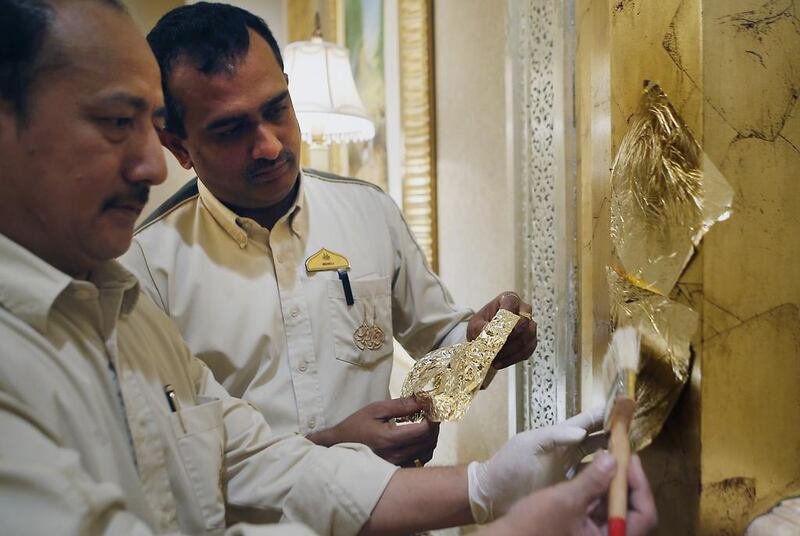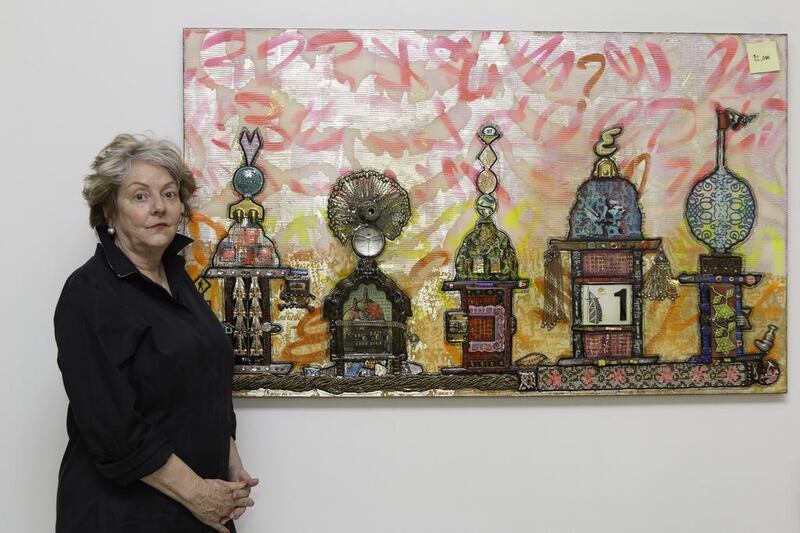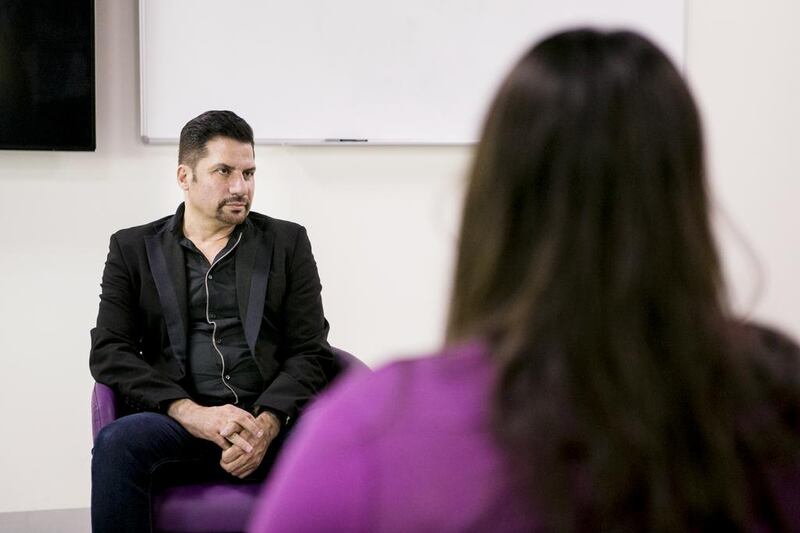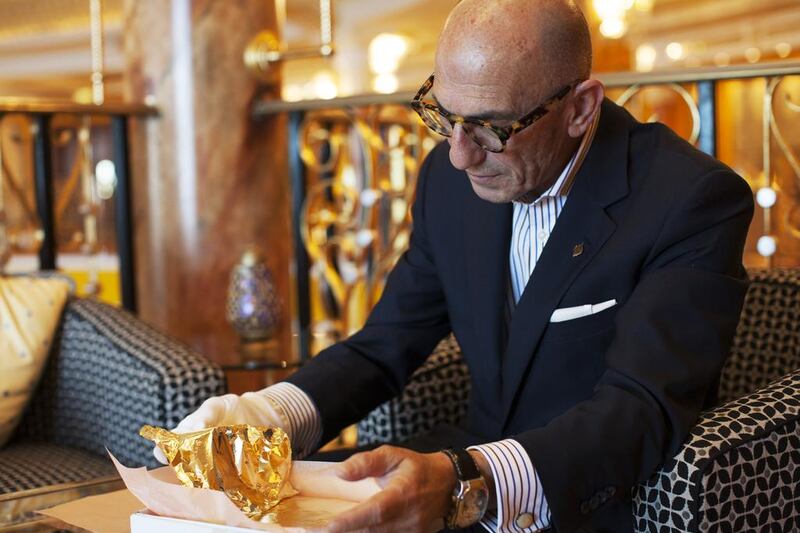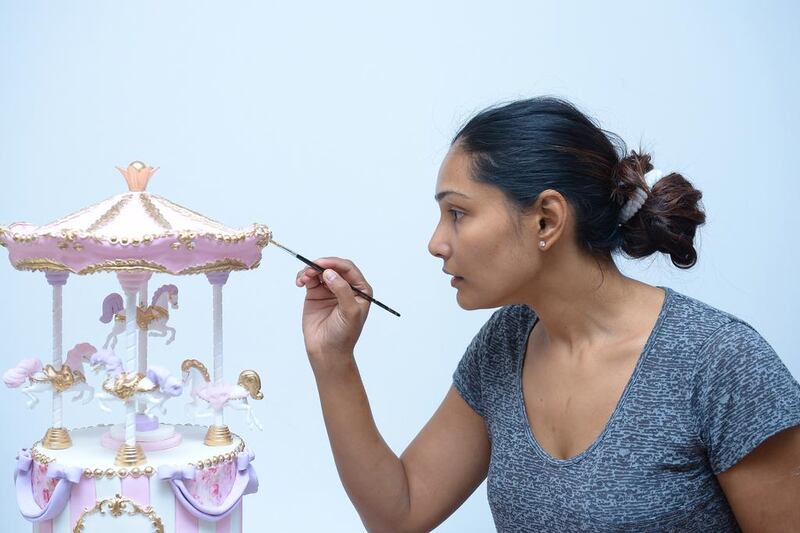It’s in facials, on cappuccinos and most recently on the award-winning Burg Khalifa. But what is gold leaf like to work with when it comes to more permanent projects? We speak to a variety of artists about this tricky material.
Gold-leaf gilder
All that glitters is gold at Emirates Palace. Most of the ceiling and many of its walls, totalling a one-kilometre surface, are covered in Italian gold leaf. Altogether, 80 kilograms of gold were used for the US$3.5 billion (Dh12bn) project, which is the second most expensive hotel ever built. Indian engineer Manoj Kuriakose (pictured) leads a team of seven, whose job is to make sure the gold maintains its stately appearance. For this, they use an age-old application process called gilding, which Kuriakose claims is not used in such a grand scale anywhere else in the world. It has to be repeated every two-to-three years, as mould regularly seeps in through the cracks.
“First of all we have to prepare the surface – clean it, sand it and apply some primer on that to protect it from fungus,” says Kuriakose. “Then we apply an enamel base paint, in various colours for different effects – in the ballroom we use yellow, which makes it look brighter, and red in the hallways. Once the paint is dry, we use gold-leaf glue to stick the squares of gold leaf.” The 22-carat gold leaf used is very brittle and thin, and Kuriakose says the skill lies in making sure it does not break.
The gilders work in shifts 24 hours a day to limit disturbance to the guests, but sometimes the guests like to watch them work. “When they see squares of gold-leaf pieces floating down, they often ask if they can take one,” says Kuriakose. “I give a little wink and turn the other way sometimes – anything to keep the guests happy.”
Gold-leaf artist
Emily Gordon (pictured) uses gold leaf in her colourful representation of Abu Dhabi. The American artist’s signature style involves layering acrylic paint, resin and discarded objects into her pictures, before gold leaf is applied and worked on using a blowtorch.
“My art is like a bad soufflé, if it doesn’t work, then I just put another layer on and just keep working it,” she says, adding that she cannot use gold leaf outside on a windy day. “Or if I’m inside an air-conditioned environment, sometimes it can also fly about all over the place. Once I heat up the resin and acrylic and I know that it is a little bit sticky as it dries, I have to just time it to apply the gold leaf.” Gordon, who brings her gold leaf to the UAE from the US at a cost of Dh500 for a book of 25 leaves of 22 carat, uses the gold foil mainly to outline buildings. “I also use it if I need something reflective in a window, or a shimmer in the water. Actually gold leaf is like a spice in that a little bit actually goes a long way. It is also one of the few materials that will not fade.”
Fashion designer
Dubai-based Lebanese fashion designer Walid Attalah has a reputation for incorporating gold, diamonds and other precious stones into his garments. Among his most expensive creations was a $1.2 million wedding dress for a Saudi princess.
“This client requested an exclusive and unique design that signifies elegance and power,” says Attalah. “I took the courage to incorporate gold, diamond and emerald in the dress, which no other designer has ever done before.” Incorporating gold into a dress can be a painstakingly delicate process. “Cutting has to be precise and accurate – producing these designs is according to clients’ request only,” says Attalah. Aside from gold and diamond, Attalah also uses emerald, turquoise, ruby, amethyst and amber for his designs.
One of the most unusual requests Attalah has had was to create a gift for Milos Zeman, the president of Czech Republic.
“His hobby is horse riding, and for his birthday some of his friends wanted to give him a unique present. When they presented his profile to me, a design of gold and diamond-encrusted horse saddle, panels and stirrups came to mind.”
Engineering director
Burj Al Arab is another luxury hotel that incorporates gold heavily into its interior. As well as using an estimated 2,000 square metres of 22 carat gold leaf, it also has gold-plated lifts and walls. The upkeep is the responsibility of its director of engineering, Mounir Lakkis, along with his Sri Lankan gold master and a team of four gold craftsmen. They make sure the gold does not lose its lustre.
Lakkis is also an artist whose works, many of which are created using gold and silver leaf, hang in the hotel’s restaurants and suites. “I was the first artist in Dubai to exhibit art with gold leaf – in 1982 – at the Intercontinental Hotel. I applied gold leaf with oysters and pearls,” he says. The hotel’s interior designer is Khuan Chew, a Briton, who also designed the Sultan of Brunei’s palace.
Chew initially designed the lobby to be painted white, but it was thought to be too dull, according to Lakkis. “So we redesigned it using a special paint with gold in it.” Much of the furniture – tables, chairs, light fittings, taps, chandeliers – and even the coffee machine and bathroom scales in the suites are gold-plated. “The challenge we have is that if the gold furniture gets damaged, you cannot just touch it up because the gold leaf changes colour with oxidation,” says Lakkis. “If you have a little damage in the leg of a chair, you have to apply gold to the whole chair, otherwise you will be able to see the spot. And if you change one chair, that means you have to change all the chairs, because you do not want one chair to look different. There’s a lot of manpower involved – it takes time. “
The golden crown of the hotel is the gold-themed bar, Gold on 27. The canopy of the bar is made from overhanging melted gold, and gold leaf gleams from the furniture and walls. “Initially the bar was gold painted, then we changed it to gold film,” says Lakkis.
Burj Al Arab also uses edible gold in its drinks and pastries.
Wedding-cake artist
Baker Gayu Lewis has been designing gourmet wedding cakes that are enhanced with gold through her Dubai-based company Sugarology for the past three years. “Gold is the most popular request that we get,” she says. “Probably out of the 100 cakes that we make, 80 of them have gold in them.” As well as sticking 22 carat edible gold leaf onto her cakes, Lewis also uses gold glitter, which she mixes with vanilla extract or alcohol to paint on the cakes for a sparkling effect. “We do a lot of very intricate work on the cakes, using moulds and things like that, which are brought out by painting them gold.” Lewis also uses non-edible gold leaf, because in this region, it is a popular trend to make a giant “fake cake” for display purposes. “It gets thrown away afterwards – most of the cake is Styrofoam covered in sugar paste on which we do the gold design.” The most expensive gold-themed cake she has made was a Dh35,000 two-metre tall cake with 16 tiers, of which 15 were fake.
artslife@thenational.ae
